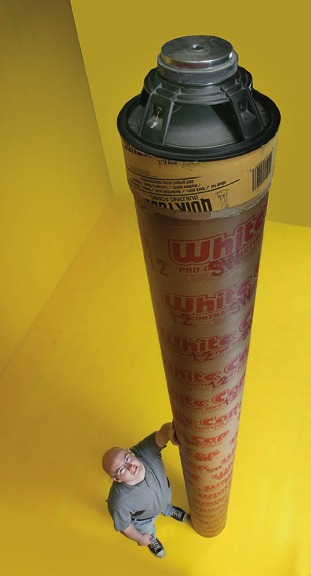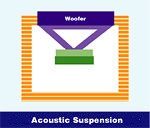Bass Is Big. Bass is Good.

Of all the parts of the home theater experience, bass certainly has the biggest wow factor. Surround sound is cool, but, when you crank up the bass, people can feel it. Bass can be the difference between "Your home theater is neat" and "Your home theater really rocks! It's like being at the movies." Getting good bass in a room isn't easy, as it's not just about engineering; it's about physics phun, too.
Is That an End Table?
Almost every subwoofer on the market today is self-powered-i.e., the amplifier powering the sub is included with, and dedicated to, the subwoofer. These amplifiers are usually extremely powerful and often need to be in order to move a large driver in their pursuit to compress (and rarefy) a whole lot of air at extremely low frequencies. Most often, these amps are Class A/B, BASH, or digital amps (for an in-depth explanation of amps, check out the June 2004 issue).
Signed, Sealed, and Delivered
 The fundamental differences in how subwoofers work lie in their cabinet designs. Deceptively, a sealed enclosure is the simplest sub design. The box behind the driver is, not surprisingly, sealed. When the driver moves back into the box, the air compresses and politely helps the driver back out the way it came. When the driver reaches its farthest excursion point outward, the air in the box (now rarefied) helps pull the driver back in. This assistance (much like a suspension on your car) gives this type of enclosure one of its official names: acoustic (wait for it) suspension. Only the energy from the speaker cone's front is radiated into the listening area, while the energy from the cone's rear is trapped in the sealed box.
The fundamental differences in how subwoofers work lie in their cabinet designs. Deceptively, a sealed enclosure is the simplest sub design. The box behind the driver is, not surprisingly, sealed. When the driver moves back into the box, the air compresses and politely helps the driver back out the way it came. When the driver reaches its farthest excursion point outward, the air in the box (now rarefied) helps pull the driver back in. This assistance (much like a suspension on your car) gives this type of enclosure one of its official names: acoustic (wait for it) suspension. Only the energy from the speaker cone's front is radiated into the listening area, while the energy from the cone's rear is trapped in the sealed box.
Like a Fine Port
 The most common subwoofer design today is the ported sub, also called vented or bass-reflex. In this design, not only does energy from the front of the speaker cone radiate into the listening area, but the energy from the rear of the speaker cone also enters the listening area through a tuned vent (port) in the cabinet. When executed well, this technique
The most common subwoofer design today is the ported sub, also called vented or bass-reflex. In this design, not only does energy from the front of the speaker cone radiate into the listening area, but the energy from the rear of the speaker cone also enters the listening area through a tuned vent (port) in the cabinet. When executed well, this technique  boosts bass output to a certain point, at the expense of a more-severe roll-off of the lowest frequencies, as well as reduced transient response (see nearby graph). Some subs utilize a passive radiator-it looks like another driver but isn't hooked up to any power-that functionally acts much like a port.
boosts bass output to a certain point, at the expense of a more-severe roll-off of the lowest frequencies, as well as reduced transient response (see nearby graph). Some subs utilize a passive radiator-it looks like another driver but isn't hooked up to any power-that functionally acts much like a port.
Bring Out the Band
 One of the lesser-used subwoofer cabinet designs is called bandpass. In essence, it's either a sealed box or a vented box with a mechanical filter in front of it. Often these are designed in such a way that all of the bass energy is radiated into the room through only a vent; the speaker cone itself isn't exposed to the listening area.
One of the lesser-used subwoofer cabinet designs is called bandpass. In essence, it's either a sealed box or a vented box with a mechanical filter in front of it. Often these are designed in such a way that all of the bass energy is radiated into the room through only a vent; the speaker cone itself isn't exposed to the listening area.
Tiny Tubes. Tiny Like the Chunnel
One design you almost never see anymore is the transmission-line subwoofer. In this design, a driver is mounted at one end of a very long enclosure, which is completely open at the other end. This enclosure can be straight or twisted around; some designs even utilize a tapered enclosure. What matters is the enclosure's length (it should be one-quarter the wavelength of the driver's resonant frequency) and diameter (determined by the driver's radiating area). Although not required, stuffing the enclosure with fiberglass or wool slows down the speed of sound through the air in the line, effectively making the enclosure act as though it were longer.
By the time the energy from the rear of the speaker cone has made it all the way along the length of the enclosure and out the open end, it's 90 degrees out of phase with the sound coming directly from the front of the speaker cone. These combine together in the room to produce the total bass output. One of the most famous commercial transmission-line designs (albeit on a small scale) is in the Bose Wave Radio. Because of their size, transmission-line subs are usually completely impractical…so we decided to build one (more on this in a moment).
Best? What's Best?
Many people will tell you that a sealed sub sounds the best, as its gentle low-frequency roll-off and agile transient response are more pleasing to the ear. However, in a less-expensive sub, a ported design will often provide a little more low-end punch, making it seem more powerful. Those who have heard transmission-line subs often swear by them, but do you really want a 13-foot-long, 13-inch-wide contraption in your living room? Luckily, today's self-powered sealed and vented designs have obviated the need for such a preposterous monolith, except for here in our flights of fancy.
Because low-frequency bass waves are so long, your room and the sub's placement in it play the most crucial role. Putting your sub in the corner will almost certainly give you the most bass, but almost as certainly the lumpiest response. Sophisticated acoustic measurement and analysis can determine the best placement. Or, if you don't mind getting your hands (and knees) dirty, place your sub at your listening position (this may take some work to get the height right) and crawl around the edges of the room until you find the spot at which the sub sounds the best; then place it there.
Many new subs ship with built-in equalizers. When used correctly, these can fix or at least alleviate many of your room's unwanted properties. If you're shopping for a high-end sub, do not underestimate the importance of this feature.
- Log in or register to post comments






























































